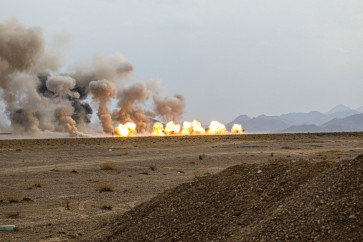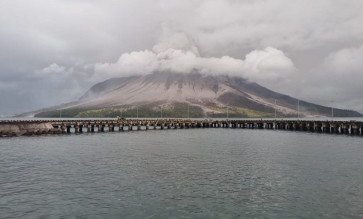Santa Cruz 21 years on, just one date in RI history
The Santa Cruz cemetery in Dili was full of people on Nov
Change Size

T
he Santa Cruz cemetery in Dili was full of people on Nov. 1. In preparation for Nov. 2, the Day of the Spirits, they cleaned the tombstones and the graves, gave them a fresh coat of paint and bought candles for the following day.
As the small flower business in Timor Leste’s capital is still too costly for most people, residents resorted to asking for flowers from neighbors’ gardens or buying plastic bouquets. The flowers were brought to churches to be blessed, before they were laid at the grave of loved ones on Nov. 2.
Across the street, the Seroja Heroes’ Cemetery was quiet, and understandably so as hardly any relatives of those buried here remain in Dili, or in the nation that has become Indonesia’s independent neighbor.
Nevertheless, those buried here are heroes to Indonesia, and mainly to their beloved families — regardless of the fact that the military invasion of East Timor in 1975, to which the US and Australia turned a blind eye, and the subsequent Indonesian presence until 1999, was illegal in the eyes of the international community.
The days before Nov. 12 also saw busy preparations for Timor Leste’s 21st anniversary of the shootings at Santa Cruz. At the cemetery, the spot of the Black Cross was expected, as usual, to draw a dense crowd of people tossing candles and flowers into a fire.
This is where families pay respect to the dead whose graves are not in Santa Cruz — either because they could not make the trip to home districts to where family members are buried — or, as in the case of the Nov. 12 casualties — family members have no idea where victims are buried, locals say.
Hence, those crowding around the Black Cross on Monday included friends and family of an estimated figure of 200 dead and missing since Nov. 12, 1991. This estimate was agreed upon by the government-appointed Commission for Truth, Reception and Reconciliation (CAVR) in its 2005 report. Several pages are dedicated to the “Santa Cruz Massacre” (cavr-timorleste.org), while the Indonesian government reported 19 dead.
On that November day, Indonesian soldiers — many of them perched behind the low walls of the Seroja cemetery — shot at a crowd of demonstrators that had entered Santa Cruz, following a peaceful street march from the Motael church.
The CAVR report leaves several unanswered questions until today, such as why soldiers continued to shoot demonstrators in the back and stab them even outside the cemetery, why combat soldiers were used instead of mobile brigade police trained to deal with riots, and so on.
But the Nov. 12 incident is only one of hundreds of samples compiled by the CAVR, which investigated and exposed human rights violations since the 1970s in Timor Leste.
Yet as the massacre in the capital had many witnesses, and even resulted in a documentary film, it is the commemoration of the “Santa Cruz Massacre” that has become one of the symbols of Timor Leste’s existence and a landmark in its popular resistance to Indonesia.
For Indonesians, news of the commemoration would be likely met with a shrug. There are too many unresolved incidents in Indonesia’s past alone.
Thus, the ignorance of Nov. 12 among Indonesians, in contrast with the commemorations mainly in Dili, does not only reflect the nature of bilateral relations — in which leaders of tiny Timor Leste are not yet in any mood to call Big Brother to account for past atrocities (the prospects of disrupted supplies of rice or cement from Indonesia are not quite a pretty picture).
The ignorance neither merely reflects a legacy of impunity of the Indonesian armed forces. Yet worse, the ignorance of Nov. 12 reflects Indonesians’ incapacity to deal with their past.
Where would we start anyway, what with too many immediate problems such as the economy and corruption?
Even though the authoritarian state that imposed the virtual ban on dissent is no longer here, we are not capable of critically questioning what exactly happened in many of our history pages.
Or we also think we would not understand the inevitable gush of information and views over each mysterious incident even if we did raise long-suppressed issues.
We would have to weigh who was really a hero and who was a villain, which would very likely lead to a need to overhaul all our comfortably familiar pictures of black and white.
Historians have not even succeeded in rewriting the history books regarding “G30S/PKI”, the political upheaval following what was said to be an aborted coup attempt by the outlawed Indonesian Communist Party (PKI).
Historians’ efforts have been met with resistance, with critics saying children could be confused with attempts to explain different versions of the “G30S” other than what was known under the New Order.
So, if the decisive moment in 1965, which propelled three decades of the New Order, is still treated with silence and resistance, Indonesians might be forgiven for not paying attention to one date in the former province of East Timor.
They might merely think Timor Leste’s independence was won with heavy international support anyway, at the cost of the world cursing Indonesia for its atrocities.
Likewise, any date ticked off by Papuans regarding this or that shooting or killing is far from conversation material among their fellow, non-Papuan Indonesians.
So far, the inability to question Indonesia’s past among its citizens is even more difficult regarding Timor Leste and Papua. Regarding 1965, for instance, many still believe the New Order’s claim that suspected communists should have, indeed, been hunted down, killed or detained without trial.
In regards to Timor and Papua, many still believe that these should be rightful parts of Indonesian territory without questioning why anyone would leave Indonesia, if not for a mischievous international conspiracy.
Hence, with different issues of atrocities, the similarity lies in the inability to question the New Order’s version.
Thus, if human rights violations were seen as an excess in defending “national interest”, few would be interested in demanding accountability from the perpetrators.
Indonesians may indeed be ignorant of Nov. 12 in Santa Cruz, but it seems that we are even more ignorant of our own rights as citizens, and as humans.
The author is staff writer at The Jakarta Post.









